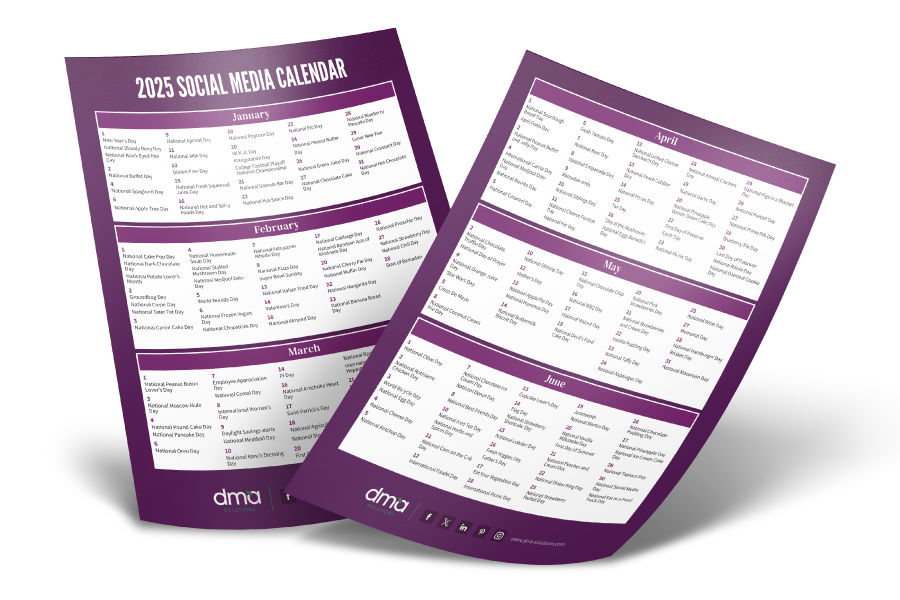As self-proclaimed trend-junkies, the DMA team ensures the office is continuously buzzing with discussions around the latest and greatest ideas to hit the marketing landscape. While this makes it easy to get a bad case of “shiny object syndrome” (remember Pokémon Go?), we do our best to mentally separate the hot trends from the long-term game changers that will transform the way we do business in the next year or more.
Looking back, 2018 was an exciting year that brought technologies like artificial intelligence and virtual reality into the spotlight like never before. Although many of our bold marketing predictions for this past year are still coming to fruition, we’re continually refining our ideas of what technologies will soon allow fresh produce marketers to tap into a new playing field of scalable solutions.
Without further ado, here are our bold marketing predictions for 2019 and beyond—and what it means for YOU, produce marketer!
Augmented reality (AR) is still on its way to becoming commonplace, but virtual reality (VR) will not go mainstream.
There is no doubt in our minds that AR is going to transform our lives in the next 5-10 years. In fact, it’s already happening: brands like Coca-Cola and Estée Lauder launched campaigns in 2018 using this technology through apps (and even Facebook messenger!). However, VR also has been hot on many produce marketers’ minds in recent years; we saw that for ourselves at tradeshows like PMA Fresh Summit in 2017. We predict that AR will end up trumping VR from a creativity and convenience standpoint (we aren’t fashion snobs or anything, but we’re 100% sure no one wants to wear that big black headset all the time!) and that VR will be relevant in very specific instances – like for medical use. AR, on the other hand, provides a greater number of content creators with more flexibility given that it necessitates only a smartphone to bring an AR vision to reality—no bulky eyewear required.
Takeaway for Produce Marketers
While AR is likely still a “shiny object” for many produce marketers focused on building social media presence and increasing web traffic, at least now we know that VR is likely not at a scalable point to earn precious marketing dollars in 2019 (unless there is a deeper, strategically sound sales strategy behind it). However, note that produce marketers still need to keep a pulse on AR advancements because your retail customers might make use of it in store sooner than you think. Overall, we recommend continuing to invest in video development in 2019, whether videos from the field, overhead recipe videos, or both of the above—and beyond!
Voice Search will change the SEO landscape and the way we write content.
Smart home devices are here to stay, and these tools are continuing to popularize voice search, which allow consumers to ask devices questions about everything from the weather forecast to instructions on how to change a tire! Soon, voice search and “the cloud” will be available everywhere we go, whether in our cars or inside a retail store. So why should marketers care? Some estimates report that by 2020, 50% of all searches will be voice search, which means that once again, the rules and best practices for successful search engine optimization (SEO) will shift.
Takeaway for Produce Marketers
Start prioritizing SEO strategies now, especially if you are launching a new website in the next year. While we expect SEO best practices to shift to accommodate voice search, making that shift will be a lot less overwhelming if you have the foundation set for search engines to find you right now. We know that specific phrases and long-tail keywords will likely play a key role in voice optimization in the future, so that’s a good—and manageable—place to start.
Automation technology will make personalized content marketing more scalable, which means consumers will come to expect it.
AI and automation technologies were once a service within reach only of those with large marketing teams (and even larger budgets). Over the past several years, we’ve seen solutions emerge that have made this approach more affordable and realistic for small businesses and others with limited funds. Furthermore, tools like Hubspot and ActiveCampaign are helping fresh produce marketers automate their marketing campaigns and create personalized content that fosters consumer loyalty. Because of tools like these, consumers are becoming more accustomed to the perception of special treatment from brands, which means that smart personalization will become a critical component for successful marketers in 2019 and beyond.
Takeaway for Produce Marketers
Invest in tools that will provide you with data to make you and your website smarter. If you have built a healthy social media presence and healthy average web traffic and now are wondering what’s next for your consumer marketing strategy, this is a great direction to consider. If you find yourself in this spot, it’s also a great time to think about getting a marketing agency involved to help you reach new heights with a personalized automation strategy to foster brand loyalty and advocacy.
Fresh produce marketers will begin to recognize and set their annual marketing spend as a percentage of sales.
Marketing in this industry has made some pretty impressive strides over the past 2 years. We’ve begun to see more brands make a concerted effort to invest in marketing strategies that will not only motivate retail customers, but also drive consumers to seek out the brand in-store. However, so many produce companies still determine their marketing spend based on an arbitrary number vs. a percentage of sales. It’s our belief that once this starts to change in the fresh produce industry, we can begin discussing ways fresh produce can someday keep pace with CPG food marketers.
Takeaway for Produce Marketers
During your annual budget planning discussions, don’t be afraid to dig deeper into the “why” behind your marketing budget and how it is determined. Ask questions and pose “what ifs,” and back your efforts up with stats that prove to help make the case for more funds in 2019. Consider this: CPG companies set their marketing spend based on a percentage of sales, and that percentage is often around 11% – upwards of 25% for some brands. Many fresh produce companies, on the other hand, have a marketing budget that has no correlation to sales. Why? Let’s start posing that very question in 2019—even if it makes for some uncomfortable answers.
Bold? Perhaps. But while these ideas may still seem light years away, technology continues to improve at faster and faster speeds each year, and marketers need to be ready for the implications of these advances. Rather than get distracted by the next “shiny object” in 2019, take time to consider what changes are likely to last and how they could affect your brand down the road, and then commit to creating a strategy to leverage new technology for the good of your brand. You don’t have to have it all figured out by 2020—and none of us can predict the future—but it’s always worth thinking ahead and anticipating what steps you can take to keep your brand relevant, regardless of how the marketing landscape changes.
Have your own 2019 predictions you’d like to share? Leave us a comment below, or tweet us @TheCoreBlog!
{{cta(‘24043446-f144-4c3f-b7a5-5313ea354b57’)}}












